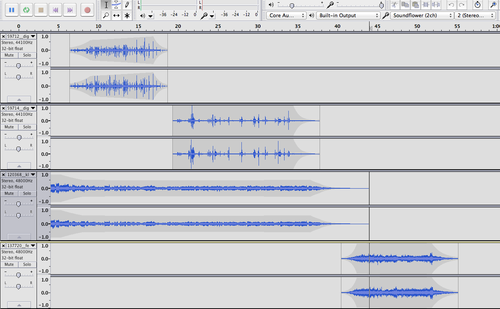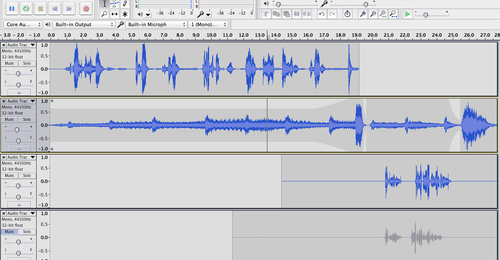Tina and Telly: A story of true friends
This video is a remixed version of, and a response to, Brian Short’s “Tina and Erich: A Love Story.”
Though Brian’s video is great in many ways, I thought a truer video would be one that showed how lovable Talky Tina is, and how Telly Savalas would, behind the scenes, love her and do nice things for her. That’s a real love story, not that mean one Brian Short did.
My goal was not only to make this video much nicer to Tina than Brian’s, but also even cheesier. Thus, I added super cheesy music and video effects.
The process
I took Brian’s original video and imported it into Apple iMovie, then cut out some parts by selecting them and choosing “split clip” (under the “clip” menu). I then selected the parts I wanted to cut and used the “delete” key.
I also wanted to make some of the clips in the original video run backwards to create the effect that Telly is actually being nice to Tina, not mean. I selected the parts I wanted, then used “split clip” again to separate them. Then, I clicked on the little “gear” symbol on the clip itself, and, under “clip adjustments,” ticked the “reverse” box.
I played around with slowing some of the clips down through the same route—under the “clip adjustments” section after you click on the “gear’ on the clip there is an option for slowing the clip down by any percentage you choose. You can also choose “slow motion” under the top “clip” menu in iMovie, but that gives you fewer options for speeds.
Brian’s video had some great repeats of clips, in which the same thing is done a few times, or the same shot is shown several times, moving in closer each time. I tried to replicate something like that in my own version, with a shot of Telly. I added a repeat of one of the clips of him, with the cigarette, by just selecting the clip and copying/pasting it right after the first one. I also used a “cross dissolve” transition between them to help it look smoother rather than a jump.
I did it originally three times, but that was a bit much, so instead I chose one repeat plus a “Ken Burns” effect on the last shot of the clip. This was done by selecting part of the clip, using “split clip” again, and then clicking on “crop, rotate and Ken Burns” on the middle part of the screen, right below where you edit the project. I had to play around with that a few times because I needed the “start” of the Ken Burns pan to be in the same place as the end of the previous clip, or the shot would jump going into the Ken Burns effect.
Finally, I used a special effect on the last clip: under the “clip” menu at the top, click on “special effect.” I used “flash and hold last frame,” which is how I got the last clip of the video to look as it does.
Of course, I added a few cheesy transitions here and there, lengthening them for effect as well.
Music
This was actually the part that took the longest. I did most of the editing on the plane to Northern Queensland (from Melbourne, Australia) where I’m on holiday right now—3.5 hrs. Then I spent two evenings looking for music. I wanted something really sweepingly emotional and over the top, something that would fit with the repeated shots/clips that seem overly romantic in the video. I just couldn’t find anything that fit exactly, so ended up with something that is a bit too happy and bouncy in comparison to what I was looking for.
I was only looking in two places for music at first:
Vimeo Music (which has some CC-licensed songs, and others that cost $1.99 for a license that allows you to use it for one project only, and http://incompetech.com/music/royalty-free/, which has music by Kevin MacLeod, who seems to compose music for film and stage projects (that’s a guess).
After an internet search I also found the Free Music Archive, which has lots of great music, but I didn’t find anything there either.
So of course, I turned to Twitter and asked people where they like to find free music, using the #ds106 and #ds106zone hashtag. I got several very useful suggestions from @cogdog, @techsavvyed, @scottlo, @indieschoollib.
ccmixter.org
jamendo.com
archive.org
soundcloud.com (which has some cc-licensed music)
And Ben Rimes has a nice page with several resources for “copyright and royalty-free media.”
The song I used was from ccmixter.org, called “We are in love,” which says it’s by “nhomas, featuring Shannonsongs,” though I don’t quite know what that means.
Questions:
1. The music I used is licensed CC-BY-NC, so I think that means I should license the whole video that way? Right?
2. But the only option on YouTube for licensing was CC-BY or “standard YouTube license,” so I chose CC-BY and tried to make it clear on the description that the video is licensed CC-BY-NC. Why doesn’t YouTube allow more CC options? Or does it and I just don’t know how to find them?
3. The video quality of my version is significantly worse that Brian Short’s original. I used the “export” function on iMovie and exported it as a “large” movie. Maybe it’s because I downloaded from YouTube and then edited and then re-exported, and it loses quality that way?
P.S.
I have another video project in mind that requires pulling numerous clips from Twilight Zone episodes, but with the very spotty wifi and phone data service I’m experiencing while on holiday, I don’t think I’ll be able to get those clips onto my computer well until I get back home to Melbourne next week. So I’ll be a bit behind in getting my second video project done!



